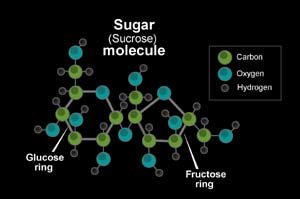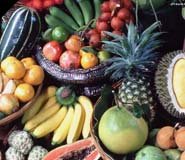3/18/2004
- - Clearly, too much sugar is not good for everybody, with all the unpleasant consequences from tooth decay to obesity and diabetes to heart disease. But how about alternatives? Does it matter where you get your sweet?
To answer these questions, it helps to understand that sugar is sugar is sugar, whether it is white sugar, maple syrup or barley malt. Though some sweeteners contain a measure of complex carbohydrates, vitamins and minerals, there are far more wholesome sources for these nutrients. And, with the possible exception of molasses, there's no advantage to one sweetener or another.
How Our Bodies Deal With Sugar
But first, let's see how our body deal with sugar. Sugars are simple carbohydrates: chemical compounds composed of carbon, hydrogen and oxygen atoms in a 1-2-1 ratio. Glucose, fructose and galactose are single sugars or monosaccharides. Double sugars, or disaccharides, have more complex arrangements: Sucrose includes one molecule each of glucose and fructose; lactose has one glucose and one galactose molecide; and maltose has two glucose molecules.

Polysaccharides, complex carbohydrates such as grains, consist of long glucose chains, plus fiber and other nutrients. Digestive enzymes reduce all carbohydrates to glucose, commonly called blood sugar, for absorption.
Whether simple or complex, the primary dietary function of any carbohydrate is energy. Both quantity and quality play a role in the body's capacity to effectively metabolize sugar. The former is pretty straightforward: Ingesting large quantities of simple carbohydrates on a regular basis strains our systems. The effect of sweetener quality is less clear cut, but a closer look at various sweeteners may help you make more informed choices.
Processed from sugar cane or sugar beets, white table sugar is 99.5 to 99.9 percent pure sucrose. It lacks vitamins, minerals, fiber, protein and trace elements. Powdered or confectioner's sugar is simply pulverized white sugar. Brown sugar is white sugar with some burnt white sugar or molasses mixed back in for color and taste.
Other sweeteners offer different flavors, textures and perhaps a slight nutritional edge compared to white sugar, though availability and price may be limiting factors.
Other Sweetners
Amasake:
This age-old, Oriental whole grain sweetener is made by culturing cooked rice with fermented rice called koji. Enzymes convert the rice starch to simpler forms, mainly maltose and glucose. Besides subtle sweetness, amasake contributes some leavening power and a wonderfully moist texture to baked goods. Buy prepared amasake or make it at home from rice and packaged koji.
Barley Malt Syrup:
This viscous, medium brown liquid sweetener is extracted from roasted, sprouted whole barley. It has a molasses-like character, and is about half as sweet as white sugar (unless corn syrup has been added for extra sweetening; check the label). It's perfect in baked goods when you don't want a pronounced sweetness.
Pure barley malt contains about half complex carbohydrates and half maltose, plus a small amount of glucose, vitamins and minerals. Refrigerate if you use it slowly or the room is warm; otherwise, it's likely to ferment. Also comes in powdered form.
Carob Powder:
This natural sweetener is usually thought of as a chocolate substitute, but the pulverized pods of the locust tree are nearly 50 percent sugar. It's most often combined with another sweetener in recipes. Carob is rich in calcium and other minerals, B vitamins and vitamin A.
Corn Syrup:
An inexpensive, clear, somewhat viscous syrup that is made from chemically refined cornstarch. Corn syrup is composed of at least 90 percent simple carbohydrates. In its purest form, it contains only glucose, but sucrose is usually added to bolster sweetness. Otherwise, its flavor is devoid of character.
Date Sugar:
This sugary-textured substance, consisting of ground, dried pitted dates, is about two-thirds as sweet as sugar. It contains iron, potassium, and other minerals and vitamins. Use it as you would brown sugar on cereal and in baking. You may want to blend date sugar to a finer texture or dissolve it in liquid for some purposes. Store in a cool, dry cupboard.
Fructose:
Although fructose occurs naturally in fruits and honey, commercial crystalline fructose and liquid fructose are highly refined substances derived from refined cane or beet sugar or corn syrup, respectively. Both are 50 percent to 60 percent sweeter than sugar and are devoid of nutrients.
Fructose is most effective as a sweetener when used raw; its sweetness diminishes greatly when cooked. Though it seems to enter the bloodstream somewhat more slowly than glucose, fructose is more likely to end up stored as fat rather than glycogen, the liver's reserve energy supply.
It may cause allergic reactions and exacerbate cholesterol and blood sugar problems in some people. But fructose may have an advantage for diabetics because, unlike other sugars, it doesn't require insulin to get into the liver and body cells. Some vegetarians choose not to use fructose because livestock feed is one byproduct of its production.
Fruit:  Don't forget the sweetening power of fresh fruit purees, dried fruits, cooked fruit sauces and butters, fruit juices and juice concentrates. The less water remaining in a fruit, the more concentrated its flavor and sweetening power. Fruits contain fiber and naturally balanced nutrients, both missing in more refined sweeteners. Winter squashes, sweet potatoes, yams, carrots and other sweet-tasting root vegetables are other mild sweeteners that also lend moistness to baked goods.
Don't forget the sweetening power of fresh fruit purees, dried fruits, cooked fruit sauces and butters, fruit juices and juice concentrates. The less water remaining in a fruit, the more concentrated its flavor and sweetening power. Fruits contain fiber and naturally balanced nutrients, both missing in more refined sweeteners. Winter squashes, sweet potatoes, yams, carrots and other sweet-tasting root vegetables are other mild sweeteners that also lend moistness to baked goods.
Granulated Sugar Cane Juice:
This is a mechanically processed, chemical-free product that physically resembles light brown sugar. It contains about 85 percent sucrose, but vitamins, minerals and other nutrients in the original cane are still intact.
Look for it in natural food stores. A popular brand is Sucanat. Mexican piloncillo and Indian jaggery, sometimes available in ethnic markets, are similarly unrefined.
Honey:
Bees drink in sucrose-rich flower nectar and convert it to glucose and fructose in the form of honey, which also contains small amounts of vitamins, minerals, enzymes and pollen. Depending on the flower source, honeys vary from light-colored and delicate to dark and intensely flavored.
All types are 20 percent or more sweeter than sugar, and are quickly absorbed into the bloodstream. For best taste and nutrients, look for honey that hasn't undergone high heat or extensive filtration. Honey is acidic and will activate baking soda; it also helps preserve baked goods. Don't give honey to children under 1 year of age; it's been known to cause botulism in infants. Many vegans regard honey as an animal product and avoid it.
Maple Syrup:
It takes 30 gallons to 40 gallons of sap containing 3 percent sucrose to produce one gallon of maple syrup that's 65 percent sucrose. Look for pure maple syrup; 'maple-flavored' syrup consists primarily of sugar or corn syrup and usually contains artificial coloring and flavoring.
Buy organic maple syrup to avoid formaldehyde, chemical anti-foaming agents and mold inhibitors. Refrigerate maple syrup in a glass jar to prevent spoilage. Maple syrup provides a flavorful sweetness with no aftertaste. Highest grade (AA or fancy) maple syrup has the sweetest, most delicate flavor and is best used as a topping. Darker, stronger-flavored grades are ideal for cooking and baking. Maple sugar is dehydrated, crystallized maple syrup; both are pricey, but worth it.
Molasses:
The thick, dark syrup that remains after sugar crystals are removed during sugar refinement, molasses' color and flavor differ depending on whether it results from early or later extractions. Strong-flavored blackstrap molasses is the residue from the final sugar extraction.
This sweetener is rich in minerals, particularly calcium and sometimes iron, but also may contain high concentrations of pesticides and other toxins.
Rice Syrup:
Rice syrup traditionally is made by combining cooked brown rice with dried sprouted barley and culturing the mixture until malt enzymes convert some of the rice starch into glucose (about 3 percent) and maltose (about 45 percent). Rice syrup retains 30 percent to 50 percent complex carbohydrates, plus some minerals and B vitamins.
Rice syrup has a subtly sweet flavor, about two-thirds as sweet as white sugar, one-half as sweet as maple syrup and one-third as sweet as honey. Store in a cool dry place. Rice syrup has a powdered counterpart, made by pulverizing crystals prepared from the liquid; it dissolves readily in liquid.
Source
http://www.findarticles.com/cf_dls/m0820/n214/16930503/p1/article.jhtml?term=
